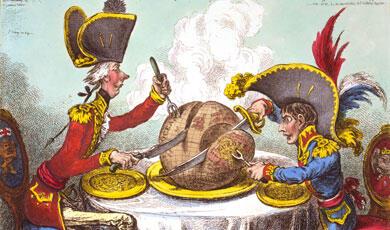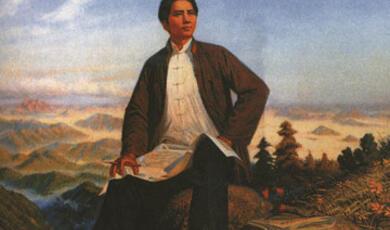Investigative Journalism: A New Global Power?
Share
- Details
- Text
- Audio
- Downloads
- Extra Reading
The Internet and enhanced tools of digitalisation and communication have given opportunities to investigative journalists undreamed of even 10 years ago, and globalisation has connected the newshounds and whistleblowers of every continent.
From Latin-America to Nigeria, from India to Poland, courageous men and women are exposing problems and holding the powerful to account and in some cases, collaborating across continents. Governments, corporations and defence establishments need to take it into account. Should we recognise it as a new global power?
Download Text
Investigative Journalism: A New Global Power?
Professor Hugo De Burgh
30th May 2022
News media have been in existence for a very long time but competing interpretations of events and policies only became the stuff of media in the English civil war period. The concept of the professional, possibly impartial, reporter came about in Britain and the USA in the 19th century, complementing the analysis and editorialising of the elite newspapers. Journalism as investigation and revelation, came to be an important function of the press in Anglophone countries and countries influenced by, or part of, the British Empire in the early years of the 20th century. By the last decade of that century, investigative journalism had become influential in many countries, from Italy to China, Russia to the USA, holding the powerful to account and revealing shenanigans. Since then, investigative journalism has been transformed through digitalisation and globalisation.
The purpose of today’s talk is to provide an update on, and overview of, investigative journalism, based on the book published last year by Paul Lashmar of City University and myself. Many of the issues raised by ijs in recent years, and the events on which they have focussed their attention, will be known to those who follow public affairs. But perhaps less familiar will be the mechanisms by which they are brought to light and how the operations of investigative journalism have changed.
In the Anglophone world of 2022 three organisations in particular are associated with journalistic investigations. They are The Global Investigative Journalism Network, the Bureau of Investigative Journalism and Bellingcat. Their present achievements all come about as a result of very great changes that have taken place in the world of journalism since last I published an edition of the book, Investigative Journalism, in 2008.
The second edition barely referred to the Internet and described IJ as still being largely the product of established legacy media operations, most of which no longer exist. Since then, we have seen develop: Data Journalism; Security & surveillance techniques to frustrate journalists; New models of funding and executing, including:
- Mission-driven journalism
- Grassroots organisations
- Verification units
The first edition nodded to the outside world only as the subject of British journalists’ investigations. But the latest edition has chapters on IJ in many different countries. The first and second editions are, now, of historical interest only. Today I shall touch upon IJ in all these countries.
The processes of investigation through obtaining huge datasets for analysis and evaluation is called Data Journalism and barely existed in 2008.
One of the most famous cases of investigative journalism of the 1970s was the Thalidomide case, in which thousands of documents and scientific reports had to be studied so that journalists could show culpability by the manufacturers of a drug that damaged thousands of people.
Today’s data journalism has a different starting point. It does not know whether there is a story in the data but examines it to find the story, checking the veracity of the data all the time.
The Panama Papers was a collection of 11.5 million diverse files of a law firm which specialized in offshore banking and tax evasion. Revealed in 2016, the files mostly contained unstructured information that was not easily categorised or sorted. Even rendering it searchable was a challenge because processing this much data required more power than any individual computer could muster.
At its peak, the International Consortium of Investigative Journalists (ICIJ) was running more than 30 servers simultaneously to index the information contained in each file in the dataset.
But change is not just in the techniques; the very anthropology of investigative journalism has had to change. For the Panama Papers, the ICIJ put together a team of more than 370 reporters from 80 countries working across 25 different languages, plus coding languages. This was collaboration on a scale never previously seen.
The technical methods used in the Panama Papers cannot be replicated because the pace of change in data management is so rapid and relentless. ‘Much of the technology employed to produce the Panama Papers is already obsolete’. But the behavioural lessons are still valid. Collaboration works.
We now move to another development, in security and surveillance. Partly as a consequence of the successes of investigative journalists, in many democracies today, systems of surveillance that (in Lashmar’s words) ‘make the Communist East Germany’s Stasi look like a tiny cottage industry’ have been installed secretly. Too often, the target of these surveillance monoliths are journalists. Oversight agencies have proved ineffective. What has proven more effective is investigative journalism. My colleague Paul Lashmar has shown us how the formal institutions of oversight have failed to reveal rendition, torture, mass surveillance and covert operations and that we must be grateful to whistle-blowers such as Julian Assange and Edward Snowden.
Julian Assange, still in prison in the UK pending extradition to the USA, revealed in 2012, through Wikileaks, atrocities committed in Iraq and related confidential information. Snowden’s revelations about the mass acquisition of telecommunications data and bulk interception of internet traffic by the US National Security Agency showed the world how technology is being deployed.
Snowden showed us a global surveillance apparatus, jointly run by the Five Eyes Network in close cooperation with their commercial and international partners, which ignored laws or accountability. We saw that the agencies have secretly negotiated for ‘backdoors’ in the security of computer programmes, social networking sites, websites and smartphones, giving an ‘extraordinary capability to hoover up and store personal emails, voice contact, social networking activity and even internet searches’.
Neither Assange nor Snowden were journalists in the traditional sense. Over the period, new ways of funding and executing IJ have come about. And this is the third development we shall look at. Investigative journalism is frequently time-consuming and expensive, requiring the two commodities that mainstream media have in short supply. For this reason, there has been a growing understanding that other actors may play a role in providing newsworthy investigations for public consumption, giving rise to mission driven journalism.
In one sense, this is nothing new. Amnesty International, among others, has been carrying out investigations for many years. Greenpeace has exposed environmental depredations.
Human Rights Watch has been investigating human rights abuses for decades. However, the ability to self-publish and the increased opportunities of open-source material mean that NGOs – Non-Governmental Organizations - themselves have been examining different ways to bring their investigations to light.
Once upon a time, as many children know, there was a group of mice which planned to neutralise the threat of a stalking cat by placing a bell around its neck. But nobody had the guts to bell the cat.
Today, there is an organization that dares to bell cats. It is Bellingcat. In a series of painstaking investigations, Bellingcat has broken some of the most remarkable and consequential stories of recent years, finding innovative solutions to seemingly insurmountable problems of volume and verification of data to reveal what was hidden. During the Syrian war and now in the invasion of Ukraine, Bellingcat has made substantive contributions to our understanding of what is really going on.
Here are some examples of Bellingcat’s operations.
The GIJN brings together many hundreds of journalists of 182 organisations in 77 countries. The BIJ is yet another of the specialist investigating operations, but other actors in this space are grassroots organisations
new ways of funding and executing IJ include GRASSROOTS ORGANISATIONS, of which Bureau Local is a model. Bureau Local is a network of over 1000 people across the United Kingdom – journalists, bloggers, coders, academics, lawyers, community leaders and activists – who all come together to work on investigations. The Bureau Local Project operates on an open-source basis wherever possible and shares resources online, including a blueprint for its own model. Projects are emerging all over, from Greece to India.
This model has proved effective and has inspired others – for example, Correctiv in Germany, which adopted the same model to set up Correctiv Lokal.
The Correspondent, the global news features platform headquartered in Amsterdam, has used the Bureau Local’s collaboration model for its latest investigation into surveillance during the coronavirus crisis. Local news is seeing a host of imaginative versions emerging, with people willingly sharing resources, technology and success stories, super-powering this movement.
We are still with the new ways of funding and executing IJ and now come to the VERIFICATION UNITS.
New technologies that can be used for verification have been taken up with enthusiasm by those working in human rights, and some have seen the possibility of collaboration with journalists. One of the most successful has been the Amnesty International Digital Verification Corps, which now operates in six universities around the world. One of the founding partners was the Digital Verification Unit at the University of Essex.
I shall now show you some video of BBC verification work. One of the most arresting examples of verification was upon a video on social media which showed women and children in Cameroon in west Africa being led away at gunpoint by soldiers to be killed. The government of Cameroon initially dismissed the video as ‘fake news’. The BBC’s Africa Eye undertook forensic analysis of the footage using digital techniques and established where and when it happened and who was to blame. This extract shows how publicly available data has changed journalism, and how the BBC has harnessed new techniques. The programme was also cut into bite-sized chunks for Twitter, which resulted in it becoming a ‘viral’ hit. [VIDEO 3’06”]
After telling of journalists’ new powers and resources, I want to introduce a corrective: THREATS TO JOURNALISTS HAVE INCREASED TOO, demanding response. We regularly hear of journalists being targeted, whether in Ukraine, the Middle East or Latin America. In response, journalists are beginning to come together to render the murder of their colleagues ineffective as a deterrent. They do so by ensuring that the murdered journalists’ work is shared and continued.
Probably the first extensive such collaboration was by the body Investigative Reporters and Editors (IRE).
With its Arizona Project, the IRE exposed the murder of a reporter called Bolles and, just as valuable, kept going his work of exposing organised crime so that criminals would know that killing a reporter would not kill his stories.
Brazil has set up the Brazilian Association of Investigative Journalism (ABRAJI), a non- profit organisation, with the same motive. ABRAJI has kept alive the work of Tim Lopes, a reporter burned to death by drug traffickers in 2002.
The Organized Crime and Corruption Reporting Project was set up in Sarajevo in 2006 and is a consortium of investigative journalists operating in Eastern Europe, the former Soviet empire and Central America.
With the Khadija Project, set up in 2015, the Organised Crime and Corruption Reporting Project (OCCRP) has continued the work of Azeri journalist Khadija Ismayilova in exposing political corruption while she was in jail.
Inspired by these, French journalist Laurent Richard developed Forbidden Stories systematically to continue the work of murdered and imprisoned journalists and to provide a technical system for reporters in dangerous situations to upload their secrets as a kind of insurance. In the event of their death or imprisonment, the secrets could be released. ‘Cooperation is the best protection’ says Richard.
As I said at the outset, not only has the very nature of IJ changed but it has been globalised. Journalism may be an Anglo-American invention, as Jean Chalaby opined in a famous article of that name, but it is now an international practice. I shall give a few examples. First, China
Before 1949, when the Communists took power, Chinese journalism was vigorous and there were distinguished investigations. From 1949, for 30 years, journalism, like Chinese society in general, went backwards with a barbaric political retreat in which there was no place for journalism. With the death of Mao Zedong journalism began to re-emerge and the 1990s saw a flourishing of investigative journalism.
Today, with the left-wing exerting pressure on government to suppress inquiry, China is going through one of its periods of ideological intensification, with journalists being thoroughly subordinated to Party functionaries. Here is President Xi telling the media that they are servants of the Party. The slogan on the wall reads: CCTV (the national broadcaster) is surnamed Party. Absolute loyalty required. Kindly bear this in mind.
The Sun Zhigang case illustrated how the limitations placed on legacy media have accelerated the shift to social media and the burgeoning influence of ‘we media’. Social media exposed the murder, in 2003, by policemen, of a student, Sun Zhigang. Like other stories that originated with netizens, it put pressure on the authorities, in this case to change regulations that had permitted the police to take Sun into custody.
In 2010 the head of the anti-corruption watchdog in Chenzhou, a city prefecture in Hunan Province, was exposed for corruption. Until recently, investigative journalism particularly targeted this kind of ‘hard’ topic of abuses of power and the wrongdoings of government departments and officials. At present it tends to deal with ‘softer’ topics such as health, environment and ordinary people’s livelihoods.
The Sanlu Milk Scandal in 2008 – adulterated milk powder ruined or killed large numbers of babies - demonstrated the changes taking place in the types of stories that concern investigative journalism.
These are the names of some current IJ platforms. You can get some idea of their attitudes from the English versions of the names.
Cui Yongyuan used to be a famous CCTV presenter, but he has now gone independent as a journalist and polemicist.
In one famous revelation, Cui noticed that the Agriculture Ministry promotes genetically modified foods, but that the Ministry’s own canteen excludes them as being unhealthy. He exposed this on his blog.
Cui has taken on the Supreme People’s Court, the film industry and its star celebrities as well as the Agriculture Ministry and its supposed experts on genetic modification.
Cui makes enemies among the powerful but gives hope to 20 million followers. For them, his exposure of frauds, corruption and malfeasance makes him a hero.
The Arab world also reflects culture-specific approaches to journalism. When training was provided to Syrian journalists by outside organisations, the trainers, being from non-Arab backgrounds, were ignorant of the specifics of Arab society and governance, let alone current issues, making clear the redundancy of the idea of ‘universal journalism’, according to Bebawi.
The Arab world is varied and, in Jordan, for example, investigative journalists have moved on from social and environmental issues to addressing political matters.
In Syria, where journalists before the war were relatively free, the war constrained them, for all the reasons we can imagine.
These are pictures from a story about child gunmen published by Daraj Media, a Syrian collective, which found that 15-30% of Isis recruits were under the age of 15.
In Turkey there is not, thank God, a civil war, but there is certainly a violent battle of ideas. Journalists in Turkey have long been pragmatic and generally secular and sceptical. This puts them, as a profession, at odds with the revival of traditional religion promoted by the current political leaders. Today, the revival of religious sentiment makes it all but impossible for Turks to practice journalism.
The name Ugur Mumcu is synonymous with investigative journalism in Turkey, following his murder in 1993. He had upset politicians by exposing their nefarious commercial dealings.
Despite threats, in the late 1990s there was a surge of IJ in newspapers such as Cumhuriyet and TV programmes such as Arena. The election of Erdogan as President brought an end to most of this, but the publishing industry held out a lifeline.
For example, in 2019 a book was published called Metastaz. It was written by two journalists, Barış Pehlivan and Barış Terkoğlu. The book is an investigation into the infiltration of the Turkish government by the Gulen Group and other religious organisations. It looks into events both before and after the coup attempt in 2016 and how other organisations are filling the gaps left by Gulen.
This picture shows Poland’s first democratically elected President, Lech Walesa and the media that blossomed after the collapse of Marxist rule.
From then on Poland had an impressive revival in investigative journalism. Over the last few years, property scams, pedophilia in the church, police brutality and neo-Nazis have been among the momentous exposures.
Gazeta Wyborcza has been tracking neo-Fascist and neo-Nazi groups in Poland for many years. Superwizjer reporters who learned about those concerts decided to investigate the activity of such groups. They managed to infiltrate the circle of Polish neo-Nazis.
The Sekielski brothers made a film about paedophilia in the Catholic Church in Poland, Tell No One, using resources raised on a crowdfunding platform only. A herald of organizational and technological transformation, the film was first made available on YouTube.
In India, there is a ‘glorious tradition’ of investigative journalism made possible by the liberal press laws inherited from the British Raj. However, despite the improvement of the hardware of journalism and therefore improved techniques, it seems that investigative journalism in India is, today, in serious decline because of the changes in its political environment.
From the 1970s through the 1990s, many exposures by investigative journalists ‘rocked’ India, testifying to the robustness of the media and the zealousness of journalists.
Arun Sinha, still one of India’s most-known investigative journalists, made his craft famous when he narrated the gory details of how over 30 jail inmates awaiting trial were blinded by police, who inserted metal spokes in their eyes and poured sulphuric acid as extra-judicial punishment for their alleged crimes.
Despite the eulogising of IJs in Bollywood films, the ‘Murdochization’, as Prasun Sonwalkar has it, of the media has crippled journalism, elevating moneymaking far over holding power to account as the purpose of media, offline or online. ‘Paid news’, often as political as commercial, squeezes out honest reportage. Media organisations and personnel critical of the party in power have suffered calamity to the extent that India’s leading investigative journalist has likened India’s media to that of North Korea.
The story of how defenceless Malaysians were being robbed of their rights, their livelihoods and their identity was told in an extraordinary tale by Clare Rewcastle Brown, Sarawak Report. Aside from the exploitation and deception of human beings, that which she investigated has disastrous environmental impacts
Without her Sarawak Report, the shameless behaviour of the then ruling Taib family would never have been exposed to the world and revealed to their victims, no matter how clever Rewcastle Brown might have been in tracing their millions and their deal-making or how brave the whistle-blowers she handled. The results included a political overturn. This tale is to be read for its lessons in craft but also for its vindication of the mission.
The Nigerian press has been vigorous since its inception in 1849. Espousing liberal ideas of a free press and watchdog journalism, it often challenged the British authorities (c. 1849–1960) under whose auspices it emerged. It has been the most politically vibrant in Africa, and ‘through watchdog journalism and investigative reporting, Nigerian newspapers have been at the forefront of democratic development in the country’.
The founding of Newswatch magazine in 1984 by Dele Giwa and colleagues redefined investigative journalism in Nigeria, although Dele Giwa met his death in the course of investigating corrupt practices under a former military dictator. Newswatch magazine pioneered hard-hitting investigative stories.
Faced with the challenges of declining advertising revenues, political pressure and the necessary moves online, IJ is in a precarious state. Journalists are embracing the online option because it affords them an opportunity to be their own boss and prioritise investigative reporting. However, their platforms are yet to make an appreciable impact commensurate with the IJ of the pre-Internet days. NOW to EUROPE.
25 of the 44 European countries are in the EU, the governance of which has always been looked at with suspicion by popular parties. In 2003, London’s Financial Times headlines revealed ‘A vast enterprise for looting community funds’ in the European commission,
Subsequently Stern reporter Hans-Martin Tillack was arrested at the instigation of the European Union on trumped-up charges eventually dismissed by the courts. His documents and other seized items were not returned to him until 2008.
EU IJs have tried hard to work together, but their traditions are very different, as are their ways of working. There is not much in common between Sicilian and Latvian approaches but an ongoing process of comparing notes and attempting collaboration are bearing fruit.
Latin America: In the 1990s, in most of the constituent countries, investigative journalism was vigorous, complementing the re-emergence of democratic politics.
It was not necessarily detached; journalists were often hamstrung by vested interests, or their editors were threatened by politicians. In such circumstances, sharing responsibility can be a way out.
Brazilian, Argentinean, Mexican and Colombian media participated in global exposures such as the Panama Papers and Paradise Papers. As with other nationalities’ journalists, such collaboration ‘demonstrates a paradigm shift where exclusivity and immediacy are replaced by a culture of information sharing and “slow” journalism’.
In 2017, the Salvadoran site El Faro worked with Univision to produce a multimedia report about the migrant crisis in Central America. Earlier, El Faro had worked with The New York Times to expose violent gangs in El Salvador. In both cases, the information was published simultaneously in English and Spanish to reach wider audiences.
Operação Lava Jato (Operation Car Wash) is the biggest political corruption scandal in Brazil’s history. In January 2016, leading daily Folha de São Paulo reported that former President Luiz Inácio "Lula" da Silva benefited from contracts carried out by construction company Odebrecht, in exchange for favouring this company in contracts with state-owned oil giant Petrobras. The reporting process included data-journalism techniques and led to investigations that uncovered an unprecedented web of corruption in Brazil that ultimately extended to at least 12 countries, imprisoning company executives and public officials.
Mexico’s Animal Politico is widely known for its stellar reporting on social inequality, political corruption, migration, social programmes, and human rights violations.
Guatemala’s Nómada and Plaza Pública produced several exposes that revealed collusion between government and larger corporations in relation to a range of illicit behaviours, including tax evasion, fraud, and illegal campaign financing. They have offered in-depth coverage of sexual abuses and femicides implicating powerful actors, as well as the challenges of socially marginalized populations.
In England obloquy shook the UK media following revelations of the phone hacking scandal. It destroyed one of its oldest newspapers and attracted widespread condemnation. A judge-led inquiry by Lord Leveson confirmed many suspicions.
Britain’s tabloids: investigations are an important part of the marketing mix for tabloid media and a way to claim the public service accolade for all British newspapers.
Revelations about the peculiar sexual proclivities of politicians, stings of vain or greedy bosses by a chap who dressed up like Lawrence of Arabia were too good to pass by, but, fortunately, stories with better claims to social value were also commissioned and published: exposures of fraudsters, violence in refugee hostels, predatory landlords, unsafe tumble dryers and suicides among army recruits indeed constituted a public service.
Private Eye sells 40% more copies than the internationally famous Economist and is the best-selling current affairs magazine in the United Kingdom. it seems laughable to the uninitiated and redolent of schoolboy humour, yet its bite is worse than its bark. Unlike its French cousin, Charlie Hebdo, Private Eye is of no evident political persuasion; bad people are bad, for Private Eye, whether they are left or right or nothing but bad.
Shady Arabia and the Desert Fix was a check on relations between UK prime ministers Blair and Cameron and Saudi leaders. Private Eye has carried out, and continues to carry out, very serious investigations as well as modest revelations which can nevertheless result in great alarm. It does so with sceptical humour, lightness of touch and exemplary professionalism.
There are regular sections which probe areas of British life such as health, local government or media.
PE editor Hislop explains how PE is an original crowdfunded production: Private Eye … depends on people in specific industries . . . engaging with us and saying if something’s going wrong, or you think something’s bent or something isn’t right, just letting us know, and that is how nearly every section of the Eye works. . .. The reason we tend to get our stories right is because we’re told them by people in the middle of them’.
I hope that I have outlined how globalisation and the Internet and Big Data have transformed investigative journalism over the past 15 years. To come are the challenges of Artificial Intelligence and increasing difficulties of cyber security. In conclusion I want to encourage you to read the book from which I have quoted and for which I had the honour to be co-editor. There is much more to learn about this great power in the world than I have managed to squeeze into an hour.
© Professor De Burgh 2022
Part of:
This event was on Mon, 30 May 2022
Support Gresham
Gresham College has offered an outstanding education to the public free of charge for over 400 years. Today, Gresham College plays an important role in fostering a love of learning and a greater understanding of ourselves and the world around us. Your donation will help to widen our reach and to broaden our audience, allowing more people to benefit from a high-quality education from some of the brightest minds.


 Login
Login







